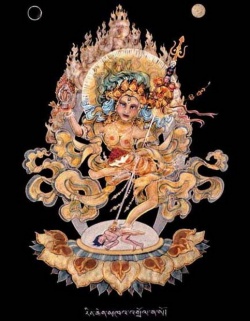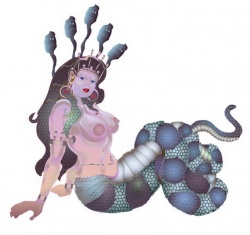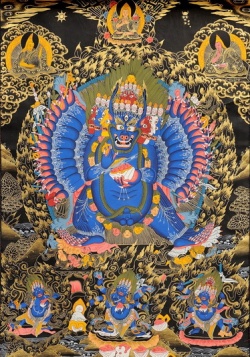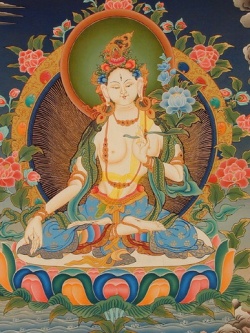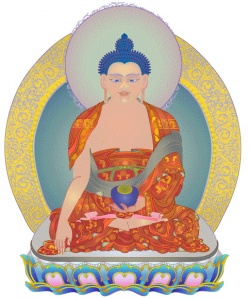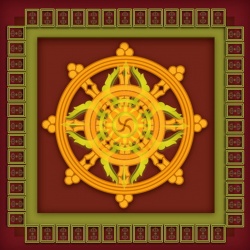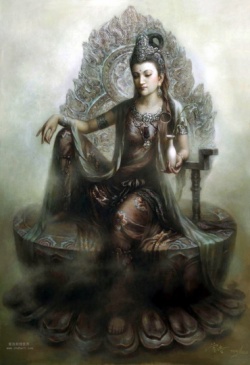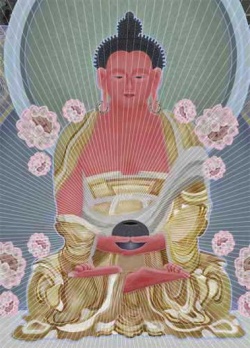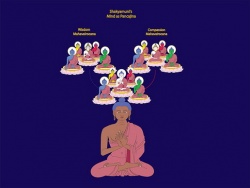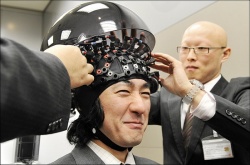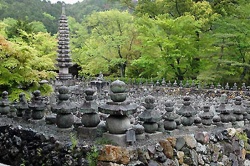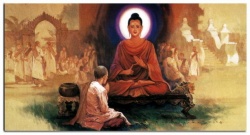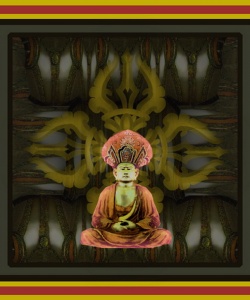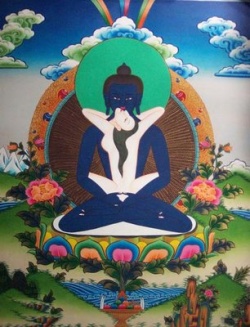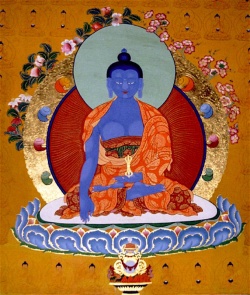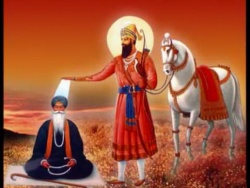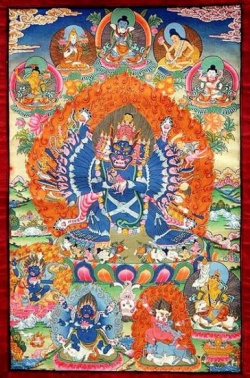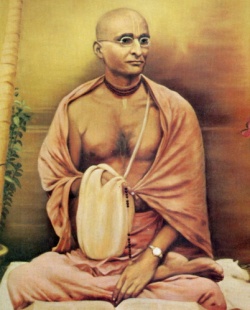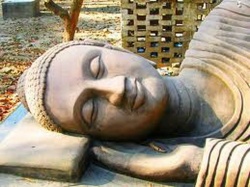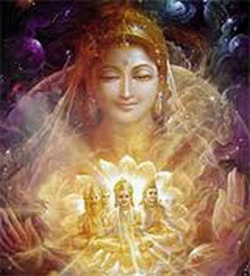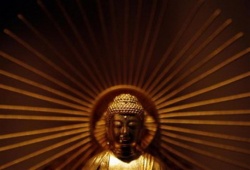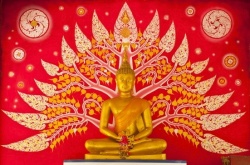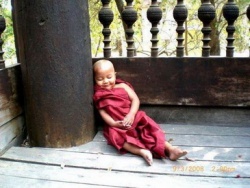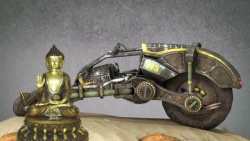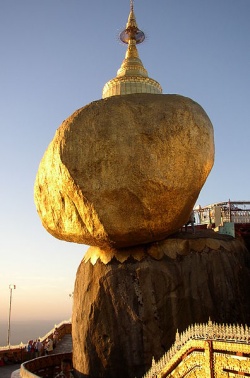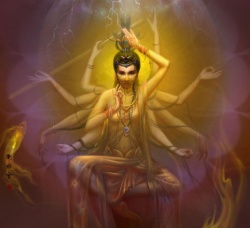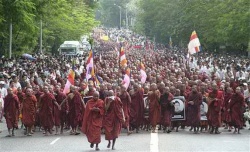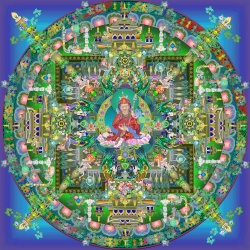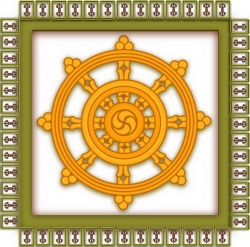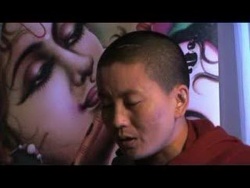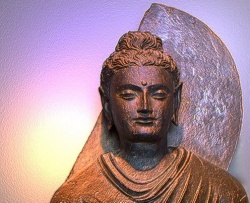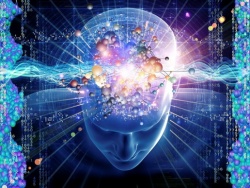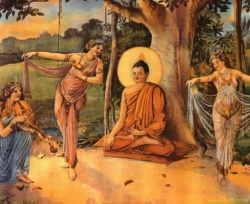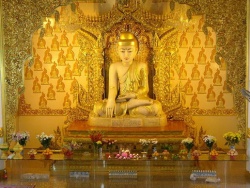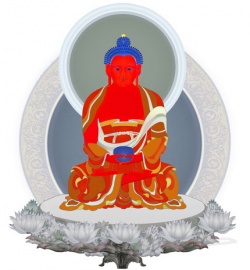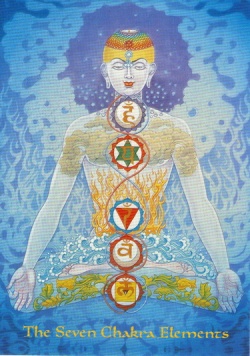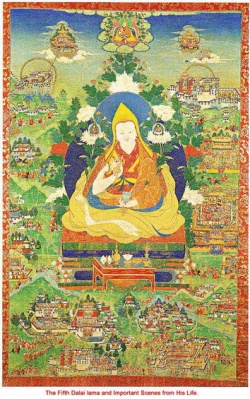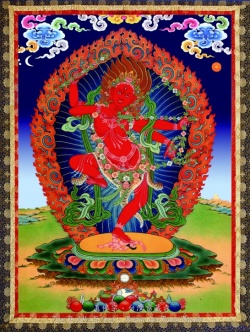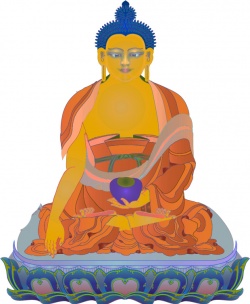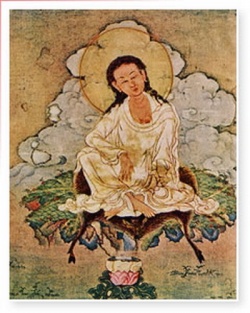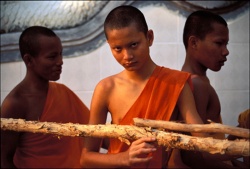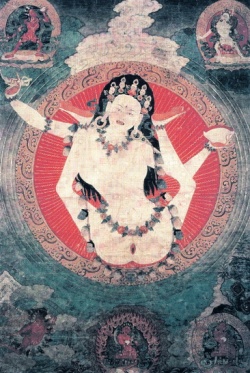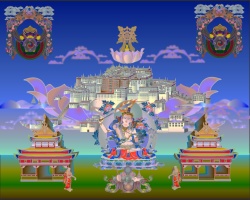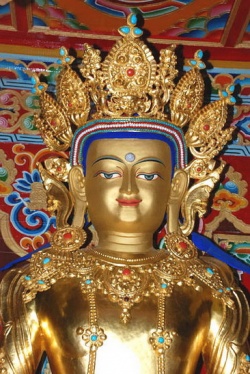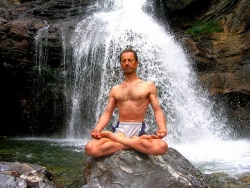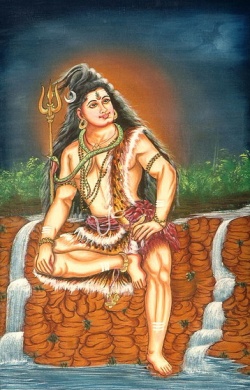The Light of Liberation: Short Commentary to the Ngondro Prayer entitled, ''The Swift Path to Enlightenment''
By Tulku Ogyen Rinpoche
The Root Text
Ngondro Prayer called the Swift Path to Enlightenment
Brief Preliminary Practice
The Four Foundations or the four thoughts that turn the mind away from Samsara
Lama Khyeno Lama Khyeno Lama Konchog Sumpo Khyeno
Teacher Care for me
Teacher Care for me
Teacher, the Three Jewels Care for me
This is the only time to obtain the difficult to obtain human birth
I will not know when the impermanent nature of death comes
In whatever realms of samsara I may be born will be a cause of suffering
The law of cause and effect of virtue and non-virtue giving rise to happiness and suffering is infallible
May the spiritual teacher hold me with compassion by leading me to the attainment of the path to liberation!
Part II
Brief Ngondro Prayer called the Swift Path to Enlightenment
Namo!
Until the attainment of enlightenment of myself and others,
I take refuge in the Three Roots (of Lama, Yidam and Khandro)
In order to obtain enlightenment for the sake of others
I generate the mind of Bodhicitta, the aspirational, practical and the ultimate
AH!
Visualize on top of one’s crown a moon seat upon a lotus flower
Upon which sits Guru Vajrasattva with his consort
The stream of nectar flows from the mantra at his heart
Cleansing all one’s diseases, demons, bad karmas and obscurations
Recite Vajrasattva mantra
Vajrasattva melts into a light and dissolves into oneself
OM VAJRASATTVA HUNG
May the merit derived from this virtuous action help me
To attain the state of Vajrasattva
And lead all sentient beings without exception
To His state
OM AH HUNG The pure realm of the three Kayas or the enlightened bodies with their prosperity
The outer, inner and secret clouds of offering
I offer them to the Three Roots and the Three Jewels
May you all accept them and bestow me the common and the supreme siddhis
OM AH HUNG GURU DEWA DAKINI SA PARI VAR RATNA MANDALA PUJA MEGHA AH HUNG
In the space above in front of one, imagine in the midst of rainbow lights
Resides the root guru Throtreng Tsal (The One who wears a skull garland-Guru Rinpoche)
Encircled by ocean of vidyadharas-Awarness Holders of the Three Lineages
Think that He is in nature the essence of all the objects of refuge
Recite the Seven Line Prayer and later the Vajra Guru Mantra
Very Brief Lineage Prayer of Nyingthig teachings– the cycle of Innermost Spirituality
Samantabhadra, Vajrasattva, Lord Prahevajra
Manjusrimitra, Shrisimha,
Jnanasutra and Pandita Vimalamitra
I pray so that my mind be blessed!
Saroruhavajra (Lotus Born Padmasambhava)
King (Trisong Deutsen), Subject (25 Disciples) and consort (Yeshe Tsogyal)
Omnicient Dharma Lord (Longchenpa), Vidyadhara Jigme Lingpa
Gyalwai Nyugu, and my extremely kind Guru
To you all I pray so that my mind be blessed!
The creeper of the mind of renunciation and enlightenment
Nourished by the nectar of the four empowerments
The lotus-like spiritual attainments through the two stages of tantric practice blossom
May you all bless me with the fruit of the four Enlightened Bodies!
The four foundations and the prayer of the Swift path to Enlightenment was composed by Youthful Abhaya.
Finally, receiving the four empowerments
The light radiating from the three syllables at their three places
Bestows blessings, empowerments and spiritual attainments
The Guru melts into a light and dissolves into me
Becoming inseparable, relax, remain in that natural state without fabrication
Khyentsei Wangpo composed this.
The Commentary
Light of Liberation
A brief explanation to the Ngondro Prayer, "Swift path to Enlightenment"
You show the unmistaken guidance of what to cultivate and what to discard
Highly illuminating the supreme and excellent path
The king of all the Sangha, who are the leaders
To the three jewels, I make obeisance
Though my intellect acquired from birth or through learning is poor
Yet with a superior intention to benefit others
And to get oneself accustomed to the path, I am going to write this brief explanation
May the great ones who possess the eyes of wisdom give me their consent!
Care for me, Lama
Care for me, Lama Triple Gem
Explanation
Lama or the Guru is one who is the essence of all the Buddhas. Outwardly, his body is the Sangha, his speech dharma, and his mind is the dharmakaya Buddha. So he is your root guru and you should pray to him in order to care for oneself.
Inwardly, he is the collection of the three roots, Lama, yidam and dakini. Secretly, one's root guru is the channel as the base, wind as the wavering and the bodhicitta as the display. Therefore, the guru or the spiritual master is the supreme leader who is the object of refuge in this life, the next and the lives to come. Though in terms of good quality, all the Buddhas may be equal to one's guru, yet in terms of kindness, the guru excels from the Buddhas.
In the Tree Sutra,
Since he shows all the positive things
The spiritual master is like a father
Since he dispels all the negative things
The spiritual master is like a mother
When one is endlessly wandering in samsara experiencing immense suffering, one has come in contact with a spiritual master who is very hard to find. As such because of his kindness, one has got the good fortune to end the cycle of birth and death. Thinking thus, one should acknowledge not just in word but from one's heart that from this day, whatever good or bad things happen in one's life, I surrender myself to the care of one's guru. With such a devotion which is without waxing or waning in the passage of time, one should initially recite Lama Khyenno! at the beginning of this prayer.
The fact that a spiritual master excels all the Buddhas is being shown both in the sutras and tantras. In sutras, its being elucidated that without relying on a guru, the shravakas or the solitary hearers, prateyakabuddhas or the solitary realizers and the assembly of bodhisattvas do not attain their respective fruition.
In one of the tantras,
The Buddhas of the one thousand eons,
All have relied upon a guru.
According to the tantra path,
The guru is the only source or the doorway to attain the common and uncommon spiritual attainments. He is also the condensed form of the Triple Gem and the three roots.
It is also being said,
Whoever sees me, sees all the Buddhas
Whoever attains my state attains the state of all the Buddhas.
Especially according to the tantra path, considering one's guru as just an ordinary human being is a perverted view, which should be discarded. Regarding one's guru as a Buddha person, one should follow his advice. Khenpo Ngagga, a great Nyingma master had said that if one sees one's guru as a human being, then the spiritual attainments received henceforth will be like a dog.
In short, like a lotus which is not stained by mud though it is born in it, so too a lama or guru is the one who may be born in the samsara but is never stained by the faults or defects of samsara. So one should know that a lama's mind always abides in the state of Dharmakaya Buddha.
The general preliminary practice consist of two chapters,
The Common outer preliminary practice
The Uncommon inner preliminary practice
The Common outer preliminary practice consist of four sections,
First Common outer preliminary practice
Thinking over the difficulty to attain the human rebirth with the freedoms and advantages
The root text says,
Today is the only time when one has attained the hard to find human birth with freedoms and advantages
Leisure or freedom means getting the freedom from the eight states or births where one has no freedom to practice dharma. Endowments means having the ten states where one is endowed with the favorable conditions to practice dharma.
The eight states where there is no freedom are;
Being born in hell, hungry ghost and animal realm
Being born in long life gods, and as barbarians
Being born with perverted views, and being born when the Buddha has not come to the world
Being born as deaf or dumb, these are the eight states where there is no freedom
The Five Individual Advantages are:
Born a human, in a central place, with one's faculties,
Without a conflicting lifestyle and with faith in the Dharma
The Five Circumstantial Advantages are:
A Buddha has appeared and has preached the Dharma,
His teachings still exist and can be followed,
There are those who are kind-hearted toward others.
How is human rebirth with leisure and endowment difficult to find?
It is difficult to find in three aspects, which are:
The causes to attain human birth
In terms of metaphor
In terms of numerical comparison
So therefore, human birth endowed with freedom and advantages mentioned above is difficult to find. Merely being born as a human being is not difficult to find.
Acharya Shantideva says,
Relying on the boat of human rebirth
One crosses the ocean of suffering
This boat is very difficult to find again in future
Therefore, do not slumber in ignorance when you have this opportunity
When one ponders over the difficulties of finding a human rebirth, most of the people think of the difficulty of just being born as a human being. This is not the right way of thinking.
When we say that the human rebirth is difficult to find, we mean that it is difficult to find in three ways, which are, the cause, through images and through numerical comparisons. The cause of obtaining human birth is the observance of pure morality, which is like the base. The condition or the favorable circumstances that make it possible for us to get human birth is the practice of the six perfections viz., generosity, morality, patience, perseverance, concentration and wisdom. They are the factors supporting the cause. The conjoining factor is the pure aspiration after accruing virtuous activities.
The images for the difficulty in finding human birth shown in the sutras is that just like a blind tortoise whose neck is very difficult to find its way into the yoke which is carried away continuously by the sea breeze and floating on the surface of a vast ocean. In the same way obtaining the birth of human being is also extremely difficult.
The way to reflect on numerical comparisons on the difficulty of getting human birth is shown in the sutras.
There are as many beings in the hell as specks of dust in the whole world, as many pretas as particles of sand in the Ganges, as many animals as grains in a beer barrel and as many asuras as snowflakes in a blizzard-but that gods and humans are as few as the particles on dust on a fingernail.
Especially the birth of human being with all the freedoms and advantages is very difficult to obtain.
From experience we can tell that the birth of beings other than humans like the animals are not difficult to find and we can find a plenty of them taking birth in the forests, oceans and on land in hundreds and thousands in large numbers at one time.
The life of animals are also easier to sustain regardless of species, forms, and so on and they can flourish without the need of health and hygiene.
Keeping these factors in mind, Lord Buddha taught that generally being born as a human being is very difficult and on top of that, the life of a human being with all the freedoms and endowments is even more difficult to find. Hence, one should make the best out of this life and never return empty handed from the land of precious gems.
The Second Common Preliminary Practice
Reflecting on death: impermanence of life
One will not know when the impermanent nature of death comes.
As spoken above, though one has obtained the human birth with all the freedoms and endowments which is through one's fortune and good karma, one should not be relaxed with contentment and should not waste one's precious time in procrastination and distractive activities.
Shantideva says,
The life like the sun and moon goes farther and farther
The lord of death like the shadow comes nearer and nearer
Guru Rinpoche said,
The four seasons; summer, winter, autumn and spring are impermanent
Day and night are also momentary and transient
If one thinks carefully, one is near the deathbed
May I be blessed with the ability to practice dharma with diligence!
Nagarjuna had said,
Life flickers in the flutters of a thousand ills
More fragile than a bubble in a stream
In sleep, each breath departs and is again drawn in;
How wondrous that we wake up living still!
Lord Buddha has also said,
Bikshus, all composite phenomena are impermanent.
How is that so?
Whatever is stored up is impermanent and is bound to run out.
Whatever is built is impermanent and is bound to collapse.
Whatever comes together is impermanent and is bound to come apart.
In short, the universe and its inhabitants all are within the boundary of impermanence.
Guru Rinpoche says,
In this worldly existence, there is no one who escapes death.
Regarding death, the impermanence of life, one of the sutra says,
If there is birth, there should be death
If there is prosperity, there should be adversity
All who are born in this world, death follows from the time of birth like a shadow.
There are four categories of taking birth, womb birth, egg birth, heat and moisture birth and miraculous birth.
Death is uncertain. We cannot tell when it occurs. It happens to everybody; young and old, beautiful and ugly, famous and ill-famed and so on. Though there is a sequence of taking birth, there is no sequence in death. For example, the life and life force of human beings are fragile like a lamp in the midst of wind.
Acharya Aryadeva has rightly pointed out,
Conditions of death are numerous;
Where as conditions of survive is few,
Even the conditions of sustenance can turn into conditions of death.
The outer causes of death are food poisoning, diseases, destructive weapons and so on. We can know from our experience that these days when we travel on train, bus and airplane, we cannot guarantee that we will reach our destination safely because any mishaps can happen.
The inner causes are as shown in the Four Tantras on Medicine,
The signs of death occurs when body begin to perish
Due to conflicts of diseases, bodily constituents and the impurities
That are opposed to each other thereby causing death
Like the destruction of Mount Meru at the end of Kalpa
The diseases of wind, bile and phlegm contained in our body, the constituents of our body like the sperm and so on, the impurities of our body like the excrement and so on, the conflict within them can finally cause destruction of life force thus leading to death which is nothing but the separation of body and consciousness. For example, the conflict within the four elements of earth, water, fire and wind can cause the destruction of the mighty Mount Meru at the end of the kalpa.
In the Kalachakra Tantra,
Like the universe that we see outside of us, the beings that live within it also cease.
As said, the outward universe which is like a vessel is also impermanent because at the end of time it will be destroyed by the seven suns and one water. All the physical world below the realm of first level of concentration of the form realm will be destroyed by fire, the realm of second level of concentration by water and the realm of the third level of concentration by air. All will be destroyed like salt dissolving in water. The time of a year is transient through the changing face of the four seasons. The sun and the moon is also impermanent because of the rising and setting phase. The mornings, evenings, hour, minute and second all the time we all are heading towards death and impermanence. The enemy is also impermanent because he or she can be turned to friend and vice versa.
All the famous people who are born one thousand years ago in this world have all passed away, those who are now famous will one day die and those who will be famous in future are also sailing on the same boat.
In short, the outer phenomena of the world and the inhabitants that live are all subject to die and decay. Hence, without wasting a single moment in procrastination and postponement, one should firmly decide to practice dharma which only will help at the time of death.
Third Common Preliminary Practice
Reflections on the defects of samsara
In the root verse,
Wherever we are born in samsara is bound to suffer
Until all the sentient beings attain Buddhahood will be born in samsara and wherever we are born in the six realms, are subject to suffer.
Guru Rinpoche said,
In this samsara, it is thus said there is always no happiness
Even the size of the tip of a pin
If there is a little joy, it is subject to change into suffering
In the Sutra of the Application of Mindfulness, it says,
The beings in the hell realm are tortured by hell fire
The hungry ghosts are tormented by hunger and thirst
The animal beings suffer from being eaten by one another
The humans suffer short life
The demi-gods suffer from war and conflict
The gods are weakened by heedlessness
Therefore, in samsara, wherever one is born there is no happiness
Even the size of the tip of a pin
Therefore, the nature of the cyclic existence or samsara is suffering and misery though it temporarily appears to be joyful. In reality the samsara is not beyond the boundary of the three different types of sufferings: suffering of suffering, suffering of change, and pervasive suffering.
In whatever realms of samsara one is born, one is subject to suffering and misery devoid of authentic and unchanging bliss. In the hell realms, beings are tormented by the suffering of hot and cold experiences. The hungry ghosts suffer from hunger and thirst, the animal beings from forced labor, demi-gods from conflict and rivalry, gods from transference and downfall into lower realms and the human beings suffer from birth, old age, sickness and death.
Especially if we consider the suffering of human beings, the suffering begins from the birth itself. For example, the suffering of birth begins when one is in the womb of mother being kept there for nine months and nine days or thirty-eight weeks time when the mother has to undergo inexpressible misery. For example, just feel how is it difficult for us to carry a small baggage for one hour or so.
When one is in the womb, as mentioned in the Sutra of Entering the Womb, the baby experiences unthinkable suffering of fear and feel as if imprisoned in the dark prison.
Finally when the baby is born, the mother has to undergo unimaginable pain and sometimes even fall unconscious facing the danger of death. It is said that the whole joints of the mother's body opens up leading to immense pain and agony. As Guru Rinpoche points out, "At the time of birth, both the mother and son take their half step towards the land of death. Except the jaw, the whole of mother's joints separate."
When the mother holds the newly born baby himself or herself, the baby feels like being thrown into a thorny bush because of the delicate skins. In this way subsequently the baby has to undergo such different sufferings when they gradually grow up.
Subsequently, the suffering of old age follows with suffering of different kinds of illnesses. Finally, one has to undergo the inevitable suffering of death which all of us dread. From the midst of wealth and possessions that one has accumulated with great hardship in this life through the five negative emotions, one will be pulled out by death like a speck of hair from the butter. And at the time of death one has to go empty handed leaving all one's hard earned wealth without being able to take even a piece of needle and a thread. Hence, the nature of samsara is not beyond the boundary of suffering. Understanding this nature, develop a intense feeling of renunciation and pledge to devote one's time in the practice of dharma in order to deliver oneself from this never ending cycle of suffering.
Fourth Common Preliminary Practice
Reflecting on the Law of Cause and Effect
In the Root Text, it is mentioned,
The law of cause and effect of virtue and non-virtue giving rise to happiness and suffering is infallible
The meaning is as follows:
All the experiences whether happiness or sorrow that all sentient beings undergo in the different realms of samsara are not caused by an outside force like a Creator as taught in some non-Buddhist schools. Lord Buddha has showed that all phenomena (composite) arises out of causes.
Hence, all sorts of happy and miserable experiences are caused by the previously committed virtuous and non-virtuous actions.
In one of the sutra, it is shown that,
From virtue arises happiness
From non-virtue suffering
Thus the virtuous and non-virtuous actions
And their effects are clearly shown.
In the Sutra requested by Arya Deva, states,
From the pungent seed
Sprouts pungent fruits
From the sweet seeds
Arises sweet fruits
In the same way,
The Ripening fruit of non-virtuous actions are suffering
In contrary, the ripening fruit of virtuous actions are sweet taste of happiness
Thus, wise men should know this truth
All suffering and happiness have their respective causes and conditions. This is shown by the great master Ngulchu Thokmey,
All suffering arises from desiring happiness for oneself
Buddhahood that is the highest state of happiness arises from the altruistic mind.
One may doubt that whatever actions that one have committed in the past may be wasted. In order to clarify this doubt,
In the Sutra of One Hundred Actions, it is stated:
The actions of all sentient beings,
Will not be wasted even in one hundred kalpas/aeons,
When the causes and conditions gathers
They will bear fruit definitely
In the Sutra of the Application of Mindfulness:
The fire may become cold
The air may be caught with a lasso,
The sun and moon may fall down on earth
Yet the fruit of actions are infallible
The actions one have committed will ripen to oneself and not to others.
As Lord Buddha said,
The fruit of actions will not be experienced by the earth, the rocks, but only by the body with consciousness.
The theory or the principle of cause and effect is almost a distinct characteristics of Buddhist teaching. This is an uncommon significant aspect of the Buddhist path. If one generates conviction and faith in the law of cause and effect, even if one does not study the teachings of sutra and tantra in detail, one will obtain good human rebirth in the next lives and gradually it is certain that one will attain the state of Buddhahood.
The reason behind this is- the fruits or effects of virtuous and non-virtuous actions are happiness and sorrow respectively. This is certain or infallible law. The fruit of virtue is happiness and the fruit of non-virtue is unhappiness or sorrow.
For example, it is impossible to grow the seedling of rice from a barley seed. In the same way, it is not possible to grow a fruit with pungent taste out of a seed of a sweet fruit. Therefore, the law of cause and effect is infallible.
Another example, I take here is the children of the same parents differ in terms of physical beauty, intellectual power and skills though they are being nourished and provided the same facilities. The causes of such differences are nothing but the degree of karma accumulated in their previous lives. Bad actions lead to bad fruition and vice versa. There is no outside force who make somebody wise and some foolish and so on.
In one of the sutras, Buddha said;
Look to the present physical state so that one will know what one have done in the past. And look to the present actions to know what one will be in future.
If you have faith or believe in the concept of cause and effect, then naturally you will understand the principle of rebirth. Otherwise, one will not know what is wholesome and what are unwholesome actions. If people do not have the right understanding of the law of cause and effect, there is no way for the achievement of peace in this world. Without understanding the basic law of causality, some people use religion as a weapon to destroy the root causes of world peace and harmony. In such cases, we can say that if there exist a religion that undermines world peace, then it is not a genuine religion because religion is something that brings pure joy and happiness to human beings. The opposite is not a religion in itself.
Foolish people or people who are short sighted just follow religion not based on reason or logic but on the strength of followers or the power of that particular religion. So, do not follow anything based on popularity or fame, but follow which is grounded on reason and logic. The one who accepts sound reasoning and logic can be called a perfect follower.
For example, Lord Buddha has not pronounced that his religion is best and people should follow his path. He also has not claimed to deliver liberation or merits and so on. This statement has not been made roughly without any sound base.
Lord Buddha himself pointed out that;
O monks and scholars!
Like a goldsmith analyzes gold by burning, cutting and rubbing
In the same way, analyze my teachings carefully
And then accept it but not out of respect for me
If there is truth in the proclamation made by some religious tradition that there is an outside force called God or Creator who makes all the happiness and suffering in this world, the why did the Creator made some rich and happy while others poor and miserable. Why did not make all the same? In that sense the creator does not seem to be honest but seems to be biased.
Therefore, as said in one of the Sutras, the truth of the suffering and happiness of beings is as follows,
The Buddhas cannot wash away the degradations of beings,
The suffering of sentient beings cannot be removed by Buddha's hand
I (Lord Buddha) can only show you the path to liberation
Whether you attain liberation or not, entirely depend upon you.
Therefore, think carefully on this verse.
Fifth Common Preliminary Practice
Reflecting on the significance of attaining liberation
In the root text, it says,
May the spiritual teacher hold me with compassion by leading me to the attainment of the path to liberation!
As mentioned before, the pervasive suffering exist as long as sentient beings are born in this samsara. Hence, the very nature of the samsara is suffering. Yet the ordinary humans do not understand this. Therefore, the exalted beings who have attained liberation have said, "Like a speck of hair is not felt when it is on a palm, in the same way, ordinary beings do not see the pervasive suffering. But the exalted beings are like eyes that can experience the hair when it get inside them, in this way, they see the pervasive suffering".
The suffering of suffering means the respective suffering experienced by the hell beings, animals, hungry ghosts, and so on.
The suffering of change is that the humans face the suffering of birth, old age, sickness and death. The demi-gods suffer from strife and rivalry. The gods suffer from transference and downfall into the lower realms.
The pervasive suffering entails once the beings have begun to reborn in the six realms, this type of suffering follows like a shadow and is suffering in nature. Thus it is called the pervasive suffering. The cause of suffering is the committing of non-virtuous actions. The means to deliver oneself from this suffering has been shown by the great scholar Vasubhandu, " The Holy Dharma is the antidote to all obscurations (that causes suffering)"
The cause of suffering is the three poisons of attachment, hatred and ignorance and combination of all these three negative emotions. The antidote to these is the three baskets of teachings, which form the sutra teachings, and the four sections of tantra teachings taught by the Lord Buddha. Thus, these teachings are the best antidote or remedy to all kinds of negative emotions and obscurations. In order to understand these teachings, one has to rely on a spiritual master and thus should have a firm determination to study the teachings systematically under the guidance of a good teacher.
Once one come to know that the nature of the ocean of samsara is within the boundaries of the three types of suffering, one will turn one's back to the pleasures of samsara and will always think of freeing oneself from samsara. Historically speaking, when our unequalled great teacher, Shakyamuni Buddha took the birth of a prince, though he had all the perfect worldly luxuries of the palace, one day when he went outside the gate of the palace, he witnessed in the four
directions of the palace the four rivers of suffering, the harsh reality of life, birth, old age, sickness and death which are tormenting the beings. The prince thought that he is also subject to these suffering sooner or later. Therefore, he ran away from the palace leaving behind his kingdom, his beloved queen and son as well as the luxuries of the palace in search of the truth, the path to freedom and deliverance and enlightenment. Leaving the household life aside, he ordained himself and after rigorous practice of meditation for six long years without food, he finally attained enlightenment and saw the truth.
This was only possible because he understood the nature of samsara as suffering and thereby attained liberation. Liberation does not exist in a far away place where one can travel, but liberation means to free oneself from the chains of attachment, hatred and ignorance which binds us and are the causes of the different kinds of suffering which we experience in life.
Lord Buddha said,
One whose mind is tamed is happy
One whose mind is tamed is good
Further he says,
Taming one's mind completely
Is the teaching of the Lord Buddha!
In the same way, Nagarjuna said,
Realizing the clear light of one's mind,
Itself is the state of Buddhahood.
Second Chapter
The uncommon inner preliminary practice
First uncommon preliminary practice
Taking Refuge
In the root text, it is said,
Until the attainment of enlightenment of oneself and others
I take refuge in the Three Roots (of Lama, Yidam and Dakini)
The explanation follows,
In the text entitled "Seventy Verses on Taking Refuge" it says,
Though all (practitioners) may (claim to) have vows
Yet, those who have not taken refuge do not have vows.
As mentioned, the basis or the foundation of the path to liberation and enlightenment is the practice of Taking Refuge. If one does not have taken refuge in the Three Jewels, one will not be considered a Buddhist.
Firstly, the object of Taking Refuge and how to take refuge will be discussed here.
The unsurpassed teacher is the precious Buddha
The unsurpassed protector is the precious Dharma
The unsurpassed leader/guide is the precious Sangha
As shown above, our compassionate teacher Lord Buddha, have sacrificed his own self-interest and sincerely worked for the benefit of others. As a result, he has abandoned cleansed all the negative emotions such as attachment, hatred and ignorance and he shows the unmistaken path of what is right and what is wrong. Hence he is the unsurpassed teacher. So we should take refuge to him as the Teacher. Whether the Buddhas appear in this world or not, the essence of their body, speech and mind is the teachings of the Three Baskets and Four Tantras, the expressed teaching and the expresser which takes the form of writings in volumes of scriptures. Thus, they are the unsurpassed protector, the dharma teachings. So, recognize the teachings as the path and take refuge in it.
Thirdly, the third Jewel, Sangha are those who have abandoned the household life and embraced the spiritual community who have the quality of eight liberations and those who have preserved and propagate the teachings through the three-fold activities of teachings, practice and spiritual activities. Hence, they are the object of reverence and refuge.
One should recognize Sangha or the spiritual practitioners to be the friend who are actually practicing dharma.
The precepts that one should follow after taking refuge are the ones that are to be accomplished and those that are to be abandoned. It is being shown in the scriptures that those who follow these precepts without transgressions, will not be harmed by evil beings both humans and non-humans.
The distinct basic path of the Buddhist teaching or the door to the Buddhist path is taking refuge in the three jewels. The basic concept behind this practice is to protect oneself and others from the suffering of samsara because they are only capable of protecting us from the miseries of existence.
For example, if one needs to travel to some unknown place where there are possible danger of attacking robbers and wild animals, one has to rely on a courageous escort. If one does so, one will be free from any harm. In the same way, in order to tread the path of liberation and enlightenment we have to rely on the ultimate object of refuge, the infallible Three Jewels until we attain the state of Buddhahood because there are lots of obstacles on the path.
How to take refuge?
Buddha is the teacher who shows the right path, so recognize him as a teacher and take refuge in him.
Dharma is the path that actually protects oneself from the fears of samsara through practicing it. So, recognize Dharma as the path and take refuge in it.
Sangha should be recognized as one's friend on the path to liberation.
In the Nirvanasutra it is said,
Those who take refuge in the Buddha
Are true lay followers;
They no longer should seek refuge
In any other deity.
Those who take refuge in the sacred Dharma
Should have no harmful thoughts.
Those who take refuge in the noble Sangha
Should no longer associate with tirthikas.
Once one has received the vows of taking refuge, in whatever circumstances one may experience, be it moments of happiness or misery, one should rely on the three jewels until the attainment of enlightenment and should not seek other objects of refuge. On top of that, one should take a firm pledge not to abandon the Three Jewels even at the cost of one's life.
The merits of taking refuge:
One will be under the protection of the Three Jewels not only the next lives, but even in this life, all the obstacles and hindrances will be cleared and all the wishes fulfilled effortlessly. The virtuous gods will protect one always and the dark or evil forces like demons and spirits cannot inflict harm upon oneself. In future lives, one will attain liberation and enlightenment. Such are the immeasurable benefits of taking refuge.
In the Stainless Sutra, it is said,
The merits of taking refuge,
If it has a form
Even the sky is small
To contain it
As said, there are immeasurable benefits of taking refuge. Hence, one should meticulously practice this teaching, which is the basic foundation of all the higher practices.
Second Uncommon Preliminary Practice
Arousing Bodhicitta, the mind of enlightenment
In the root text, it says,
In order to obtain enlightenment for the sake of others
I generate the mind of Bodhicitta, the aspirational, practical and the ultimate.
The meaning of this is clearly described by Dza Paltrul Rinpoche,
If it (the mind of enlightenment) exists, it is enough for the attainment of enlightenment
If it does not exist, there is no other substitute for the attainment of enlightenment
The unmistaken seed of the attainment of Buddhahood
May the extremely pure and supreme mind of enlightenment arise within me!
As mentioned, the mind that has the two aspects of aspiring for the enlightenment for the sake of all sentient beings is called Bodhicitta or the mind of enlightenment.
If whosoever does not have this supreme mind cannot be considered a Mahayanist but will fall into the practitioner of the lower vehicle teachings.
Bodhicitta consists of two, the relative and the absolute. The former consists of two types, the aspirational and the practical. The different between these two can be understood through this example. There is a difference between the mind that aspires to go to a specific place and the action that takes place to reach that destination. Similarly, the mind that aspires to attain the enlightenment is the Bodhicitta of aspiration and the actual action performed in order to attain enlightenment is called the practical Bodhicitta.
The precepts of the Bodhicitta of aspiration are the cultivation or the generation of the four immeasurables of loving kindness, compassion, rejoicing and equanimity. The precepts of the practical Bodhicitta are the engagement in the six perfections. They are the practice of generosity, observing morality, practicing patience, making virtuous effort, practicing concentration and finally cutting the two extremes of exaggeration and deprecation through developing wisdom.
Benefits of Practicing Bodhicitta:
Shantideva says,
Whether one is a father, or mother
Who does have such an altruistic mind?
Even the god and the sages
Or the Brahma does not have such a mind.
If one generates Bodhicitta,
In one instant, the weak innocent beings
Bound in the prison of samsara
Will consider such a person
The son of the Victorious Ones
And will be the object of veneration by the humans and worldly gods
Summary
The mind of enlightenment or Bodhicitta, which is a Mahayana, thought and practice is not a selfish though of liberation for oneself. It is a courageous thought of single-handedly carrying the responsibility of not only just arousing compassion for all the sentient beings, but also actively engaging in practicing the methods to lead all the beings to enlightenment. Sentient beings pervade the space and suffering pervades all sentient beings. Therefore, cultivating this vast and extensive motivation is the Bodhicitta and employing the vast method to attain Buddhahood is the motivation of Vajrayana.
In short, when we talk of benefiting others, it should not be just lip service or just empty words. Compassion that is partial or biased is limited which is not beneficial in the long run. The compassion which is devoid of partiality and which does not have slightest stain of selfishness and that can sacrifice even one's life for the benefit of others can be considered genuine compassion.
Even if one cannot generate such a genuine compassion, taking a vow or pledge not to harm other beings is also appreciable. Going a step further, by actually benefiting others is better than that and therefore, cultivating a warm heart, kindness and sense of concern and caring for others is the heart of Buddhist teaching. Thus, one should know this.
As Chandrakirti says,
The Shravakas and Pratyekabuddhas are born from the Buddha
Buddhas are born from Bodhisattvas,
Compassion, the non-dual mind, and Bodhicitta are the causes of Bodhisattvas.
Third Uncommon Preliminary Practice
The Meditation and Recitation on Vajrasattva for the purification of bad karmas and obscurations
In the root text,
AH!
Visualize on top of one’s crown a moon seat upon a lotus flower
Upon which sits Guru Vajrasattva with his consort
From the mantra at his heart flows the stream of nectar
And cleanses all one’s diseases, demons, bad karmas and obscurations
The meaning of this is as follows,
AH symbolizes the unborn empty nature of all phenomena. Out of emptiness, instantly imagine that above the crown of your ordinary body is Vajrasattva with his consort who is inseparable with one's Guru and the union of luminosity and emptiness. At their heart, is a Hung syllable encircled by a garland of Vajrasattva mantra from which stream of nectar flows that enter one's whole being cleansing away all the diseases, evil spirits, bad karma, obscuration, faults and downfalls and one's body transform into a clear crystal body. With such visualization, recite the one hundred-syllable mantra and the six-syllable mantra many times.
Further in the root text,
Vajrasattva turns into a light and dissolves into oneself
OM VAJRASATTVA HUNG
Finally recite Om Vajra Sattva Hung and imagine that Vajrasattva melts into a light and dissolves into oneself thus becoming one with Vajrasattva in body, speech and mind. At the end of the practice, dedicate the merit for the sake of all sentient beings by reciting,
With this merit, may I instantly
Reach the state of Vajrasattva
And lead all beings without exception
To that state
Summary
All the sentient beings in samsara have from beginingless time, taken birth repeatedly in this cyclic existence and accumulated bad karma and obscuration resulting in unending suffering that beings experience. The best method to cleanse away all those accumulated impurities is the meditation of Vajrasattva and reciting his mantra. This is because, as shown in the Stainless Confession Tantra, when Vajrasattva was a practicing Bodhisattva, he has made infinite aspirational prayer pledging that when he attains the ultimate enlightenment, may all beings who have committed bad karma and are obscured, and who have broken their samayas, and those who have committed enormous faults and downfalls, be perfectly cleansed by praying to Him or meditating on him and reciting the one hundred syllable mantra with faith and devotion and thus save them from the suffering of hell realms and even those who have committed the five heinous crimes be liberated. Thus, due to this aspiration that Vajrasattva has made, this specific practice is significant in cleansing bad karma and obscuration. This is an oath taken by Vajrasattva himself. Therefore, Vajrasattva becomes an extraordinary deity for destroying all our bad karmas and obscurations. Since his words are words of truth, they are infallible. Therefore, one should diligently practice this with strong devotion.
Fourth Uncommon Preliminary Practice
Practice of offering Mandala-the swift gathering of the two accumulations
In the root text, it reads,
The pure realm of the three Kayas or the enlightened bodies with their prosperity
The outer, inner and secret clouds of offering
I offer them to the Three Roots and the Three Jewels
May you all accept them and bestow me the common and the supreme siddhis
OM AH HUNG GURU DEWA DAKINI SA PARI VAR RATNA MANDALA PUJA MEGHA AH HUNG
This consists of the three Mandalas of the three kayas or the enlightened bodies.
The Outer Nirmanakaya Mandala
The third-order world system and the one hundred million pure realms adorned with the seven precious stones replete with gems as well as all the complete prosperities of the human and god realms, offering them actually or through imagination in heaps is the outer Nirmanakaya mandala offering.
The Inner Sambhogakaya Mandala Offering
Through imagination, one should offer the densely arrayed realm of Akanistha having the five certainties heaped with the pure realms of the five Buddha families.
The Third Secret Dharmakaya Mandala Offering
The boundless mandala of All Basis, on which is heaped the samsara and nirvana and offer it to the Guru of the three kayas is the secret Dharmakaya mandala offering.
We can also classify all offerings into the outer offering of the five sense objects, inner offering of the medicine, blood and torma, secret offering of the Primordial wisdom of supreme bliss. Thus, whether the objects of offering which are being owned or not owned by any individual, one should offer them to the three gurus of the three enlightened bodies.
One should pray that may you all accept these offerings and bless one with the eight spiritual activities including Pacification, Enrichment, Magnetization and Destruction and the eight common spiritual attainments.
The meaning of the mantra is that I am making this offering of the sublime and precious mandala to the lama, yidam and dakini.
By carrying on this mandala practice, one will gather the two accumulations and cleanse the two obscurations finally leading to the attainment of the two enlightened bodies. Temporarily, one will be wealthy in this and the lives to come.
Summary
It is very important to gather the two accumulations. As Longchen Rabjampa points out, "A person with accumulated merits will have all his wishes come true". Paltrul Rinpoche has also said," It is better to gather a spark of merit than to make huge mountain of effort." Therefore if one does not accumulated virtue, one will not get merit. If there is no merit, one's wishes will not be fulfilled, be it the purpose of this or the next live, spiritual or temporal goals. Hence it is important to gather merits.
For example, some people who have accumulated merit, they become successful and prosperous in all their endeavors without the need of much effort. Though some people will make the same degree of effort and have the same determination towards their worldly goals, only those with merit will be blessed with success. This is a very obvious fact.
In order to accumulate merit, the best method or means is to offer mandala. This consists of the offering actually made and the one done through imagination.
The actual offering means to offer the best quality of different objects that are wonderful, clean, precious and pure. This should be done according to one's economic resources and should be offered to the Three Jewels without the stain of stinginess or attachment.
Imaginary Offering
Even though one does not have many wonderful things to offer, through imagination, whatever wonderful things one has seen in this world that are owned or not owned by any individual can be offered. One can offer through imagination the lovely mountains, lush green forest, clear streams, mighty oceans and even the shining moon and sun. For example, on the way, if you come across a picturesque landscape with natural grassland adorned with beautiful flowers having natural beauty, then instantly, one should think that I am offering the beauty of nature to Three Jewels, the objects of refuge with faith, devotion and delight. In that case, one will accumulate enormous merit, which is far better than the actual offering because the imaginary offerings done will not be bound by stain of stinginess.
In short, the best way to accumulate merit is to offer Mandala.
Fifth Uncommon Preliminary Practice
Receiving the blessings through the Guru Yoga Practice
The root text says,
In the space above in front of one, imagine in the midst of rainbow lights
Resides the root guru Throtreng Tsal (The One who wears a skull garland-Guru Rinpoche)
Encircled by ocean of vidyadharas-Awarness Holders of the Three Lineages
Think that He is in nature the essence of all the objects of refuge
Recite the Seven Lines Prayer and later the Vajra Guru Mantra
The meaning of the above verse is as follows,
Before the existence of Guru
There is not even the name of Buddha
Even the Buddhas of the thousand Kalpas
Came into being by relying on a Guru
Even the Lord Buddha said,
When the final Five Hundredth cycle comes,
I will miraculously come in the form of Guru/Teachers
And will benefit you and others
As mentioned above, both the sutra and tantra teachings, the Guru is shown in nature to be the Buddha. Here, the Guru Yoga practice follows thus,
In the space in front of you, in the midst of rainbow light, visualize your Guru in the form of the Great Acharya Padmasambhava, who is the gathering of all the objects of refuge. The Lotus Born Vajra (Guru Rinpoche) is free from the cycle of birth, death and old age and has a white complexion with pinkish hue wearing brocade and the three robes of a monk. He has one face and two hands, the right hand holding a Vajra at the heart, the left holding a skull cup upon which rest the vase of immortality. He wears the lotus hat and in the cleft of his left hand, he holds a trident symbolizing his consort, the mother of bliss and emptiness.
Guru Rinpoche resides in the midst of a rainbow light encircled by the gurus of the three lineages, the mind transmission lineage of the Buddhas, the symbolic lineage of the Vidyadharas and the aural lineage of the yogis. Visualize these clearly and think that Guru Rinpoche is the condensed embodiment of all the Buddhas and Bodhisattvas of the three times and ten directions, the sole object of refuge.
With such a conviction and visualization, recite the seven-line prayer of Guru Rinpoche and also the Vajra Guru Mantra as much as possible.
Some people wrongly think that the Seven Line Prayer is being composed after the birth of Guru Rinpoche. This is not the fact. Actually, all the Buddhas of the three times and the ten directions uttered the Seven Line Prayer unanimously.
So, it is a Vajra word of all the enlightened beings and not just conventionally composed by some scholars.
Therefore, whosoever with great conviction and faith, recites this prayer will be freed from the miseries brought out by diseases, evil spirits in this and life and if we are skillful and competent enough to propitiate and supplicate Guru Rinpoche, he is the Buddha of wisdom, longevity, Medicine and so on. Hence he is the combined essence of all the Buddhas. In future lives, we will be born in the Glorious Lotus Light Copper Colored Mountain, the pure realm of Guru Rinpoche. Such are the manifold benefit of reciting this prayer.
Particularly, Guru Rinpoche has prophesied that in this degenerate era, which we so call as modern times, when the thoughts and actions of beings go astray from the virtuous path of holy dharma, disease, famine, warfare, and strife will befall.
The inner and outer elements of nature will become imbalanced that will give rise to unknown and unheard at earlier diseases like Cancer, Plague, Ebola, AIDS, Hepatitis A, B & C, SARS, Bird Flu, H1N1 and so on which the world has so far witnessed. Furthermore, he has predicted that one-fourth of the human populace on this earth will perish due to the occurrence of eighteen different kinds of infectious diseases in future. Similarly, he has also foreseen a time in future when the world will be plagued by cattle diseases, epidemics, negative influences of planets, Nagas, Gods and spirits, and elemental spirits, failure of crop due to drought, frost bite and hailstorms, war and conflict, flood due to heavy rainfall, tsunamis, earthquakes, volcanoes, forest fire, and fire that extinguishes villages, cities and towns.
Thus, whenever the destructive forces of the four elements occur, whosoever prays to Guru Rinpoche with unshakeable faith, Guru Rinpoche himself has promised that he or she will not be affected by these destructive forces of nature and will be saved.
Essence Mantra is:
OM AH HUNG VAJRA GURU PADMA SIDDHI HUNG
The meaning is Lotus Born Vajra Guru who is the embodiment of the three enlightened bodies, may you bless me with the common and supreme spiritual attainments!
Summary
Lord Buddha prophesied the Great Acharya Padmasambhava when he was about to pass away.
The prophecy read thus:
After my passing away
When one hundred and twelve years have passed
In the island of Lake Danakosha
A person greater than me will come
In the Sutra called Extensive Wisdom, it says,
In order to criticize the eternalistic view, I passed away
In order to criticize the nihilistic view, I appear forty-three years (after the parinirvana of Lord Buddha)
In the island of Dana Kosha, upon a lotus flower
Having attained the wonderful spiritual attainments, I will become a King's son
The Inconceivable Sutra further says,
Due to the fortunate and marvelous activities
Of the Buddhas of the three times, their embodiment
(Appears) on the wonderful lotus flower
In the form of an awareness-holder
In the tantra called Penetration of Sound,
After my passing away
In the Western Land of Oddiyana
In the Dana Kosha Lake, on a lotus
(Will appear) a son without a father called Vajrahe
Who will hold the teachings of the sublime masters
In the Secret Tantra of Dakini, it says,
In the middle of the kalpas
In the midst of the ten sacred places of Heruka
I will appear in the form of an awareness-holder
And will become the master holder of tantra teachings
In the Manjusrinamasamgiti, it is said,
The Glorious Buddha born out of a lotus
Holding the treasure of enlightened wisdom
Assuming different manifestations of king and so on
Great Buddha, holder and the King of Mantras
As shown in many sutras and tantras, Lord Buddha has prophesied that Guru Rinpoche is inseparable from him and accepted to be his own manifestation. Therefore, without wavering from the enlightened mind of Buddha Amitabha, the Vajra speech embodiment of all the Buddhas of the three times, Guru Rinpoche appeared from Amitabha's unceasing expressive power of compassion taking various miraculous emanations through which he benefited all sentient beings.
As shown in Pema Kathang, it is clear that, Guru Rinpoche, through the three ways of looking, from the HRI syllable at the heart of Dharmakaya Buddha Amitabha, emanated a five-pointed golden Vajra, which rested upon the lotus in the milky lake of Danakosha situated in the North Western part of Oddiyana, giving birth to Guru Rinpoche miraculously. Later he was invited as the son of King Indrabodhi. Gradually, in the eight charnel grounds and the twenty-four tantric sites, Guru Rinpoche displayed varied virtuous activities leading to the eight different names respective to each activity.
In this world, he generally illuminated the general teachings of Lord Buddha and particularly, the Vajrayana teachings and also benefited many beings and brought happiness to many beings like the rays of sun, before finally departing to the South West Land of Cannibals. If Guru Rinpoche has not gone to that land of Rakshasas, there was a great danger of human beings being attacked and consumed by the cannibals. So, through Guru Rinpoche's tantric prowess, he subdued them by liberating their king and assuming as the King of the Rakshasas, named Thoetreng Tsal.
He is beyond the cycle of birth, death, and old age and he is more powerful in spiritual activities than the other Buddhas and Bodhisattvas. The reason behind this is that he is the combined essence or the collective embodiment of the power of all the Buddhas and Bodhisattvas of the three times and ten directions. Moreover, he is not born from a mother's womb and deliberately came to this world to tame the beings of this degenerate age. Hence his compassion and activities excel all the other Buddhas.
Guru Rinpoche himself has promised that whoever has faith in him; he will be sleeping at the door of that person for protection. Especially if one pray to Guru Rinpoche on the Tenth day of each Tibetan Month, he has gave a word that he will come personally on that day. In essence, the Buddhas of the three times are inseparable with Guru Rinpoche. This is being supported by this proclamation made by Guru Rinpoche,
"The Great Vajradhara residing in the Densely Arrayed Realm of Akanistha,
The Great Sage, Lord Buddha residing in Bodh Gaya,
Both of them are inseparably complete in me."
Again, he further says,
If you see me, you see all the Buddhas,
If you accomplish my state, you will accomplish the state of all Buddhas
I am the condensed essence of all the Buddhas.
Thus, other than Guru Rinpoche, there is no supreme object of refuge in this and next lives.
Short Lineage of Nyingthig Cycle of Teachings
Samantabhadra, Vajrasattva, Prahevajra
Manjusrimitra, Shrisimha,
Jnanasutra and Pandita Vimalamitra
I pray so that my mind be blessed!
Saroruhavajra (Lotus Born Padmasambhava)
King, Subject and consort
Omniscient Dharma king (Longchenpa), Vidyadhara Jigme Lingpa
Gyalwai Nyugu, Tenpai Nyima
To you all I pray so that my mind be blessed!
Ngagi Wangpo, Shedrub Nyima
Drubpai Wangchuk Pema Norbu
Great Vidyadhara Thupten Palzang
To you all I pray so that my mind be blessed!
To the creeper of the mind of renunciation and enlightenment
Nourished by the nectar of the four empowerments
The attainments through the lotus like two stages of tantric practice blossom
Thus bless me with the fruit of the four Enlightened Bodies.
Finally, receiving the four empowerments
From the text:
The light radiating from the three syllables at their three places
Bestows blessings, empowerments and spiritual attainments
The Guru melts into a light and dissolves into me
Becoming inseparable, relax; remain in that natural state without fabrication
The meaning of the above verse is as follows:
From the three syllables, OM, AH and HUNG at the three places of crown, throat, and heart of the Guru, light radiates and dissolves into the one's three places, thus cleansing the three obscurations of body, speech and mind. Think that in this process, you attain the indestructible body, speech and mind of the Guru and also the common and supreme spiritual attainments.
The guru that one has visualized at the crown melts into a light and then dissolves into oneself. Think that one become one with one's guru in body, speech and mind. Then without fabrication, cut the thoughts of the past, present and future and remain in the natural state of shunyata or emptiness for a while.
Then, rise from the meditation and dedicate the merit derived from it for the benefit of all the sentient beings.
Branch Practice to the Actual Dzogchen Instruction, the Short Cut Path of Phowa Practice
There are many different types of Phowa Practice. They are:
The excellent phowa of sealing with the view of Dharmakaya
The mediocre Sambhogakaya phowa of the Union of the two stages
The inferior Nirmanakaya phowa of the immeasurable compassion
The hook-like compassionate phowa that leads the death to liberation
The ordinary phowa of the three imaginations
The phowa practice comprises of learning how to practice and the undertaking the phowa.
Firstly, Great Guru Rinpoche said,
"The consciousness wanders like a foolish dog in the bardo (intermediate state)
(In such circumstances) it is difficult to lead it to the higher realms."
So, without perfecting the phowa practice oneself when one is alive, it is absurd to do the phowa on others. It is same as a person without hands trying to climb a rocky mountain.
Even Milarepa says,
Without seeing the reality oneself,
One should not perform phowa on a dead person.
If the dead person had practiced phowa when he or she is alive, only upon such circumstances, it is appropriate for a person who has not broken any samayas to perform phowa with the correct visualizations. This is the statement made by the Victorious Vajradhara himself.
There exist many instructions on phowa practice, but Amitabha himself who appeared with Avalokitesvara and Vajrapani in person to Tulku Terton Migyur Dorje gave the present specific phowa teaching. Thus it is an ear-to-ear transmission. This contains both the essence of the Kama and Terma teachings and is especially more powerful in blessings than other instructions. Any individual having any level of intellect can practice and it is definite that with the right method, signs will occur.
All of us who are born will die one day because death is inevitable and no one can escape this reality. At the time of death, there is no other profound, beneficial and essential practice than this.
Therefore, begin the phowa practice with taking refuge and arousing bodhicitta.
The main visualization
Instantaneously, you become the Lord of Great Compassion, Avalokitesvara, with a white body, peaceful smiling face and four arms. The first two hands are pressed together at the heart. The lower two hold a crystal rosary and a white lotus flower. He sits cross-legged on a lotus and moon seat in the full lotus position. His hair is tied up at the crown and adorned with a jeweled diadem of five sections. Adorned in silken garments and jewels, he possesses the major and minor marks. Meditate in this way upon his body of blazing light. In addition, the outer form of the Great Compassionate One is like a white silken tent, empty inside like an inflated balloon and luminously transparent. In the center of his body is the central channel (Tsa U-ma), which possesses four characteristics: Externally the channel is white, the sign of its blissful nature. Internally, it is red, the sign of clarity. It is exceedingly straight, the sign of the path to Buddhahood. The lower section is blocked below the navel, the sign of having sealed off the door to the lower realms. At the peak of the crown, the channel is wide open, the sign of the open path to the Pure Land. Meditate in this way.
Visualization of the Three Deities
Above my head, upon a jeweled lion throne, lotus and moon seat,
Is the protector Amitabha, red in color,
With one face and two hands. He rests in equipoise,
Holding a begging bowl and wearing the three robes of a fully ordained monk.
He is seated with both feet in the posture of Maitreya Buddha.
His two big toes
Are resting over the uppermost point of my central channel
To his right is Avalokitesvara, white in color,
With one face and four arms. His upper two hands are pressed together
And the lower right and left hands hold a rosary and lotus flower, respectively.
He is standing upon a lotus and moon seat
To his left is the possessor of power, Vajrapani,
With one face, two hands and blue in complexion
His right hand holds a Vajra, his left, a bell
He is standing upon a lotus and moon seat.
Countless Buddhas, Bodhisattvas, surround them,
Hearers and solitary realizers
In the three places of the three root deities
Are the three seed syllables, from which light radiates forth
Invoking the primordial wisdom beings from the Realm of Great Bliss, who then dissolve into them.
Phowa Prayer
How very astonishing are the protectors Amitabha,
Avalokitesvara and Vajrapani
With a mind of single-pointed devotion, I pray to you.
Grant your blessing that I may practice the profound path of Phowa.
When the uncertain time of my own and others' death arrives,
Grant your blessings that our consciousness may be transferred to the Realm of Great Bliss.
(Recite this prayer twenty-one times or more)
Blocking the Impure Doors
In your heart, within the central channel, obstructed like the joint in a bamboo shaft, is a red eight petalled lotus. Upon this is a moon mandala, the size of a pea split in half. Upon this is the condensed nature of one's subtle mind and air, as a white essential drop (Bhindu) marked inside with a luminous red syllable HRI complete with the two circles. Meditate that it vibrates up and down. From this HRI, several light rays in the shape of HRI radiate out to the eight orifices blocking the door to the rebirth in the six realms of samsara.
If there are any difficulties in getting a clear visualization, imagine that the stream of ambrosia of longevity flows from the begging bowl of Amitabha, which fills one's body completely. The dharani mantra of Amitabha is OM AMI DEVA AYU SIDDHI HUNG
Finally, Amitabha and the entourage of Avalokitesvara and Vajrapani dissolves into a light which in turn immerses into oneself and seal off the opening of one's crown by a HAM syllable and crossed Vajra.
Secondly, the Actual practice
Though the visualization is same as above, the consciousness should be transferred through visualization to the heart of Amitabha who is seated with a cross-legged posture. If it is done in this way, though the person who is dead does not becomes a Buddha, in the intermediate state, the doors to the next life in samsara will be closed and thus will be born in the pure realm of Sukhavati and gradually the obscurations are exhausted which then swiftly leads to Buddhahood.
Thus, the preliminary prayer cum practice entitled, "Swift Path to Enlightenment" in the authentic teaching of Jamyang Khyentsei Wangpo, who is Manjusri in human form. This teaching has been received and passed down to my uncle, Pema Sherab who is the personal physician to Jamyang Khyentsei Wangpo who has daily practiced it.
At this time of modern era, we see that majority of people on this planet have short lifespan and on top of that they are too busy working for their livelihood, and whatever spare time they have, they are lost in the illusive pleasures of life and have no time or leisure to practice dharma.
Hence, for their purpose, I deeply felt for a long time that a clear explanation to this short root text is the need of the hour. Therefore, under the direction of my beloved guru, His Holiness Penor Rinpoche, on the auspicious day of the Tibetan month, 17th Rabjung cycle, Wood Monkey Year, when I was giving the Ngondro Teachings to a group of more than three hundred students both monks and lay person in Namdroling, I completed this exposition on the 24th day of the 3rd Tibetan Month.
I, Ogyen Gyurme Wangyal alias Dongag Nyima, the 9th incarnation of Thrakya Palden, the emanation of Drogmi, was born in Dokham province, the source of siddhas in the honorable clan of Nyagrong Thrakya A-Go Pon wrote this commentary.
Final Words:
I confess being obscured continuously (in many lifetimes)
By the gathering of stained virtues, non-virtue and neutral actions
This small effort that I have made with pure motivation
May it help in liberating all beings from the dense cloud of ignorance!
_____________________________________________________________________________________
This commentary is dedicated to my root Guru (teacher), H.H. Pema Norbu Rinpoche, who has every single minute worked for all beings, dedicating his entire life to furthering Buddha Dharma and World Peace.
By the benefit of this merit may he get well soon and live a long life.
I authorize anyone who is interested to copy this and practice it.
